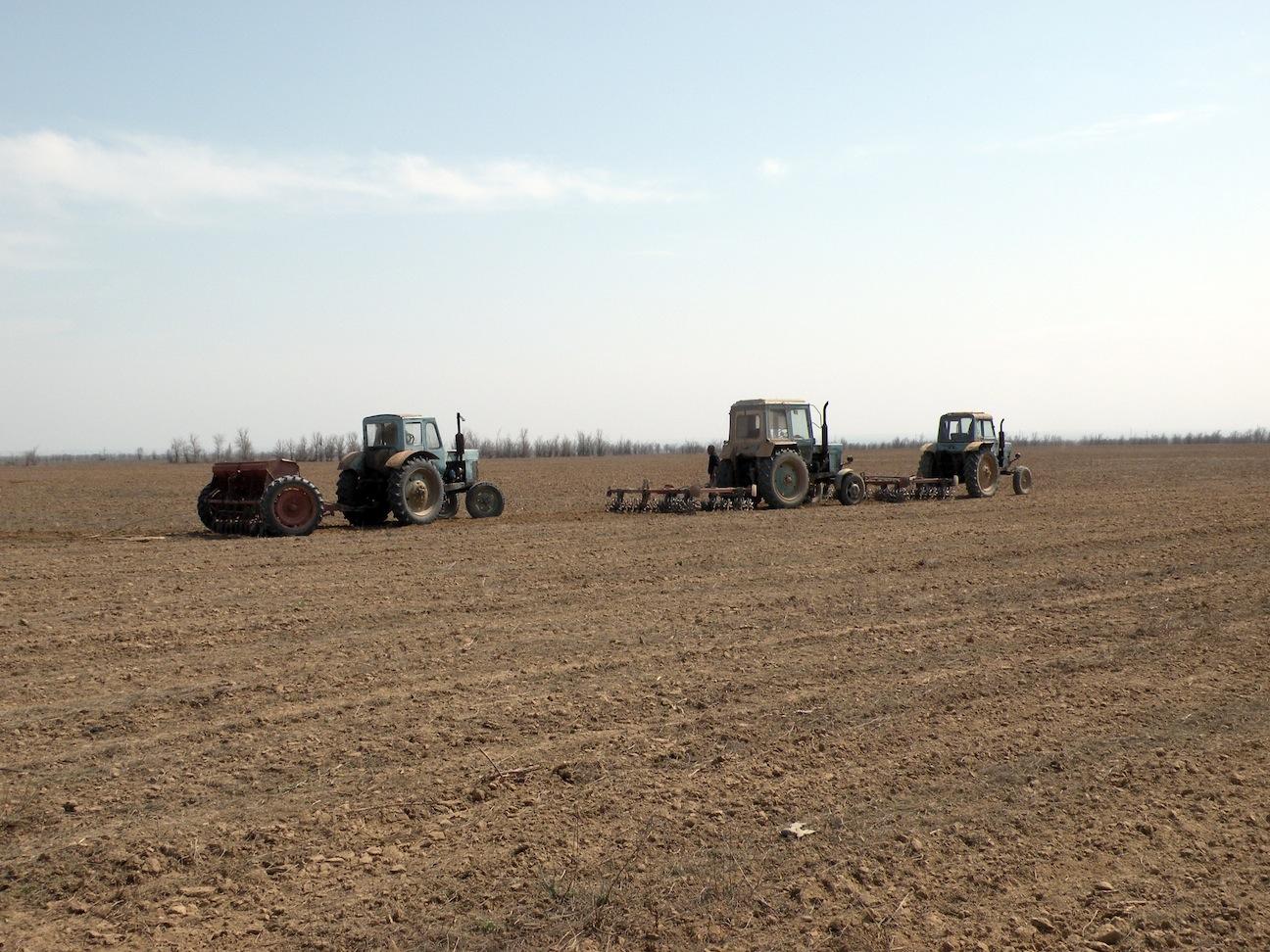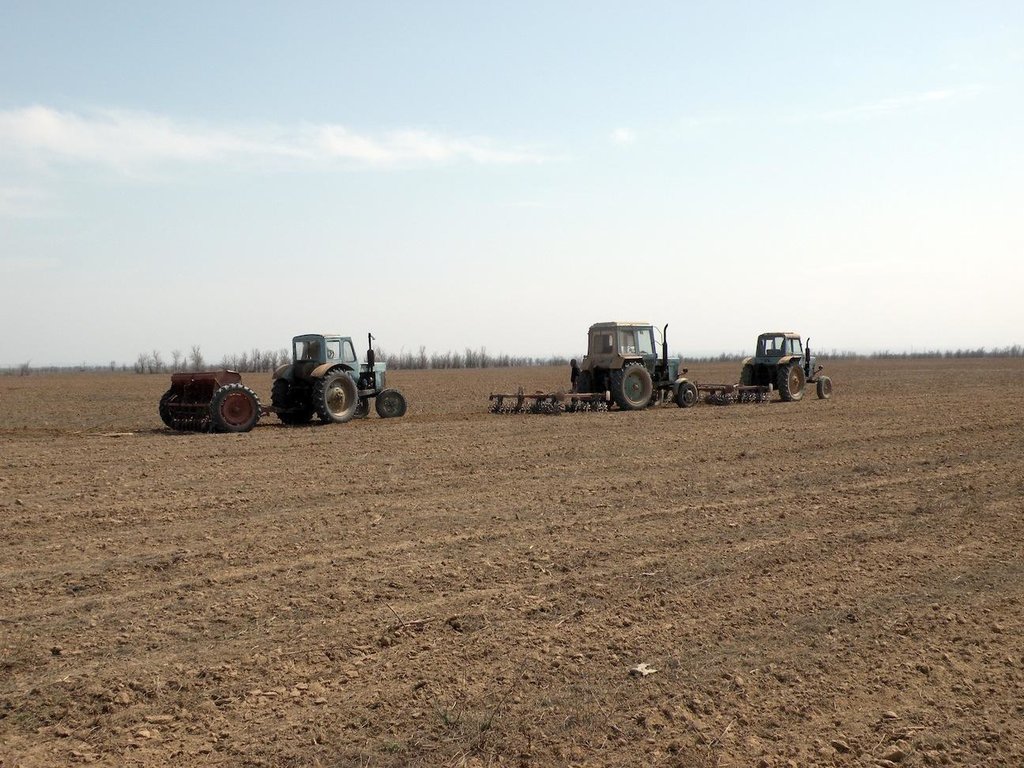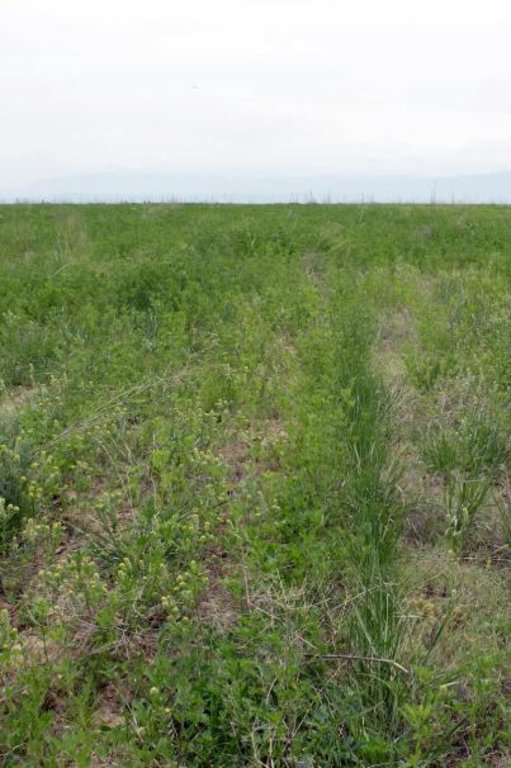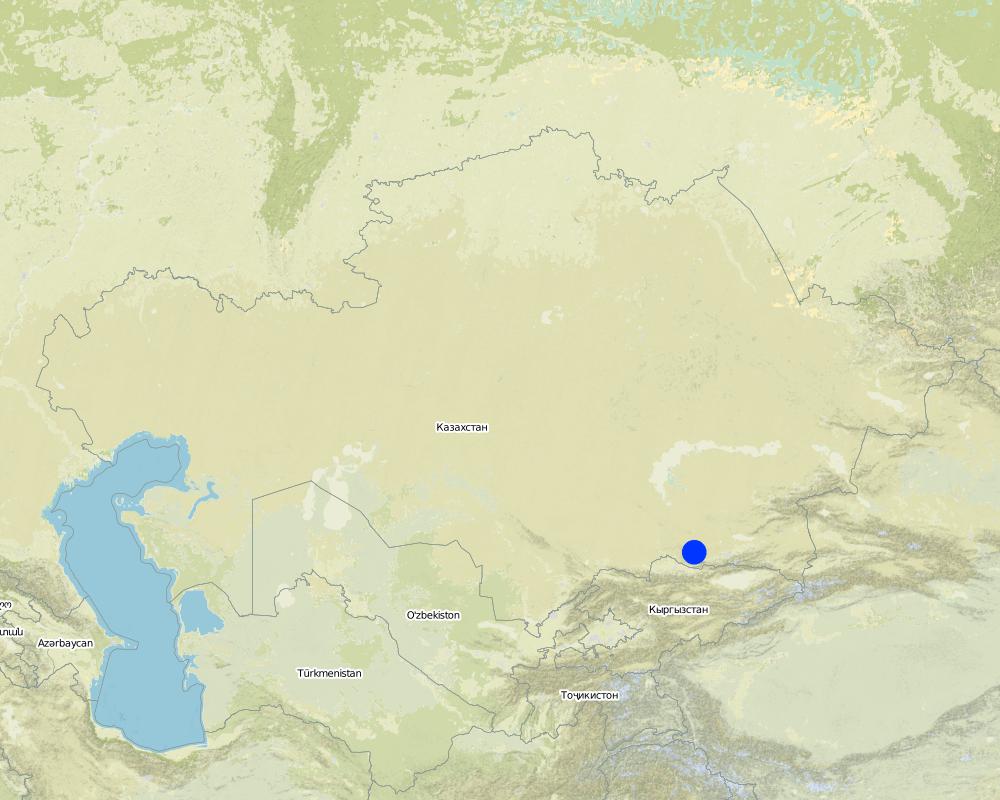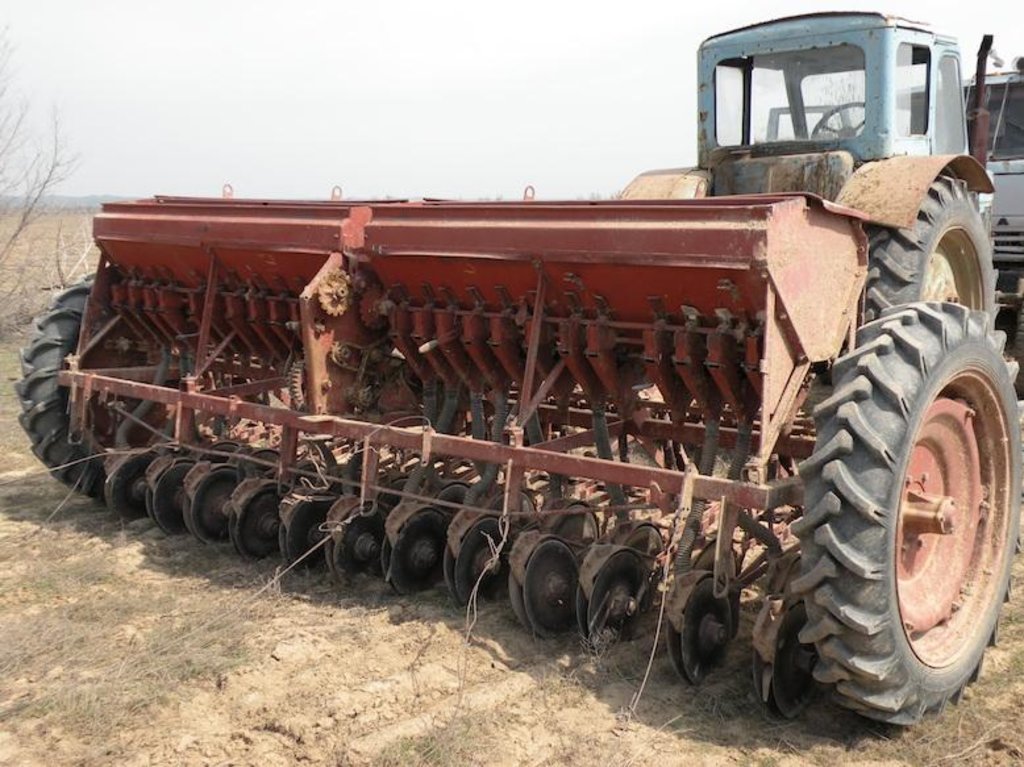Fallow restoration by no-tillage seeding [Kazakhstan]
- Creation:
- Update:
- Compiler: Heino Hertel
- Editor: –
- Reviewers: David Streiff, Alexandra Gavilano
Seeding of forage grass on fallow land
technologies_1175 - Kazakhstan
View sections
Expand all Collapse all1. General information
1.2 Contact details of resource persons and institutions involved in the assessment and documentation of the Technology
SLM specialist:
Sadyk Baktiyar
Zhasyl Azyk Fund
Kazakhstan
Name of the institution(s) which facilitated the documentation/ evaluation of the Technology (if relevant)
Deutsche Gesellschaft für Internationale Zusammenarbeit (GIZ) GmbH (GIZ) - GermanyName of the institution(s) which facilitated the documentation/ evaluation of the Technology (if relevant)
United Nations Development Program (United Nations Development Program) - Tajikistan1.3 Conditions regarding the use of data documented through WOCAT
The compiler and key resource person(s) accept the conditions regarding the use of data documented through WOCAT:
Ja
2. Description of the SLM Technology
2.1 Short description of the Technology
Definition of the Technology:
Fallow land restoration for fodder production is combined with biodiversity conservation of natural steppe vegetation by no-tillage disc-harrowing and seeding of forage grass in low density.
2.2 Detailed description of the Technology
Description:
In March a plot of 380 ha twenty years abandoned wheat fields with stable perennial weed stadium, dominated by Artemisia lessingiana was cultivated by shallow disc-harrowing and seeding with A. cristatum. Agropyron cristata is a useful pasture grass, but it is invasive and tends to dominate an area for more than 15 years. For this reason, the seeding was done in half density then usual during Soviet time (10 kg/ha instead or more than 20 kg/ha) to avoid the strong dominance of the fodder grass and to maintain a balance between already established steppe vegetation and fodder grass. By disc-harrowing the dry inflorescens of Artemisia were destroyed and the dominance of this species diminished. This leads to a more species-balanced vegetation, which can provide fodder and hay and reduces the risk of locust mass development.
Purpose of the Technology: The fallow land in Kazakhstan comprises more than 10 million ha. With the climate change the agro-ecological zones will shift northwards, greatly reducing the area of the country in which cereals may be produced. As a result, more fields will be abandoned and the area of fallow land will further increase. After a few years, at most fallows a stable perennial weed stadium dominated by Artemisia lessingiana develops, which is not well eaten by livestock and promotes the mass development of locust.
Plowing and seeding with forage grass Agropyrum cristatum is the common method to minimize the risk of locust mass development and the production of fodder. But the seeding with A. cristatum has negative effects on soil structure and humus content and leads to a permanent vegetation strongly dominated by the forage grass and reduction of biodiversity.
With no-tillage cultivation and seeding in low density the biodiversity of steppe vegetation will remain and enriched with forage grass for utilization.
Establishment / maintenance activities and inputs: The cultivation was carried out in March 2010 by the farmer and his staff and his own machinery. The project provided the costs for seeds and fuel. After 1,5 years, in September 2011 the results were evaluated by botanists, project staff and the farmer. The field shows a balanced vegetation structure of natural steppe vegetation and sown forage grass with a moderate dominance of grass. The goal was fully achieved.
Natural / human environment: The technology of plowing and seeding with forage grass is well known by all local stakeholders, including the farmer. The adaptation to use no-tillage cultivation and half density of seeding was introduced by the project staff and is based on the results of an other project.
The farmer was ready to try the new technology on his farmland and provided land, machinery and staff. Other farmers, local and regional authorities, and the Ministry of Agriculture were interested in the results, which were published and used in other areas.
2.3 Photos of the Technology
2.5 Country/ region/ locations where the Technology has been applied and which are covered by this assessment
Country:
Kazakhstan
Region/ State/ Province:
Almaty Oblast
Further specification of location:
Zhambyl Rayon
Specify the spread of the Technology:
- evenly spread over an area
If the Technology is evenly spread over an area, specify area covered (in km2):
3.8
If precise area is not known, indicate approximate area covered:
- 1-10 km2
Comments:
Total area covered by the SLM Technology is 3.8 km2.
Map
×2.6 Date of implementation
If precise year is not known, indicate approximate date:
- less than 10 years ago (recently)
2.7 Introduction of the Technology
Specify how the Technology was introduced:
- through projects/ external interventions
3. Classification of the SLM Technology
3.1 Main purpose(s) of the Technology
- improve production
- preserve/ improve biodiversity
3.2 Current land use type(s) where the Technology is applied
Land use mixed within the same land unit:
Ja
Specify mixed land use (crops/ grazing/ trees):
- Agro-pastoralism (incl. integrated crop-livestock)

Cropland
- Annual cropping
Annual cropping - Specify crops:
- fodder crops - grasses
- vegetables - other
- wheat
Number of growing seasons per year:
- 1
Specify:
Longest growing period from month to month: March - November

Grazing land
Extensive grazing:
- Semi-nomadic pastoralism
- Ranching
Intensive grazing/ fodder production:
- Improved pastures
Comments:
Grass species: Agropyrum cristatum
Major land use problems (compiler’s opinion): At most fallow lands a stable perennial weed stadium dominated by Artemisia lessingiana develops, which is not well eaten by livestock, does not allow hay production and promotes the mass development of locust.
Major land use problems (land users’ perception): Fallow land is bad pasture, does not allow the production of hay and has the risk for mass development of locust. Thus, improvement of vegetation species composition of fallows for the use as pasture, fodder and hay production and minimizing the risk of locust mass development is very important.
Future (final) land use (after implementation of SLM Technology): Grazing land: Gi: Intensive grazing/ fodder production
Livestock density: 1-10 LU /km2
3.3 Has land use changed due to the implementation of the Technology?

Grazing land
- Extensive grazing
3.4 Water supply
Water supply for the land on which the Technology is applied:
- rainfed
3.5 SLM group to which the Technology belongs
- pastoralism and grazing land management
- minimal soil disturbance
3.6 SLM measures comprising the Technology

vegetative measures
- V2: Grasses and perennial herbaceous plants

structural measures
- S5: Dams, pans, ponds

management measures
- M2: Change of management/ intensity level
Comments:
Secondary measures: management measures
Type of agronomic measures: rotations / fallows, zero tillage / no-till
Type of vegetative measures: aligned: -graded strips *<sup>3</sup>
3.7 Main types of land degradation addressed by the Technology

biological degradation
- Bs: quality and species composition/ diversity decline
Comments:
Main causes of degradation: crop management (annual, perennial, tree/shrub) (decades of wheat production and abandoned because of low production)
Secondary causes of degradation: change of seasonal rainfall, inputs and infrastructure: (roads, markets, distribution of water points, other, …), education, access to knowledge and support services
3.8 Prevention, reduction, or restoration of land degradation
Specify the goal of the Technology with regard to land degradation:
- restore/ rehabilitate severely degraded land
Comments:
Secondary goals: prevention of land degradation, mitigation / reduction of land degradation
4. Technical specifications, implementation activities, inputs, and costs
4.1 Technical drawing of the Technology
Technical specifications (related to technical drawing):
Grass seeding was done with normal drilling equipment but only 50% density of seeds.
Technical knowledge required for field staff / advisors: moderate
Technical knowledge required for land users: moderate
Main technical functions: promotion of vegetation species and varieties (quality, eg palatable fodder)
Secondary technical functions: increase in organic matter, increase of biomass (quantity)
Aligned: -graded strips
Vegetative material: G : grass
Grass species: Agropyrum cristatum
Change of land use practices / intensity level: extensive used fallow was converted into forage production land and intensive grazing land
4.2 General information regarding the calculation of inputs and costs
Specify currency used for cost calculations:
- USD
4.3 Establishment activities
| Activity | Timing (season) | |
|---|---|---|
| 1. | disc-harrowing, seeding | March |
| 2. | Purchase of seeds | |
| 3. | Delivery of seeds | |
| 4. | Repairing machinery, work |
4.4 Costs and inputs needed for establishment
| Specify input | Unit | Quantity | Costs per Unit | Total costs per input | % of costs borne by land users | |
|---|---|---|---|---|---|---|
| Labour | Repairing machinery, work | ha | 1.0 | 2546.0 | 2546.0 | 100.0 |
| Equipment | Machine use | ha | 1.0 | 6311.0 | 6311.0 | 3.0 |
| Plant material | Purchase of seeds | tons | 4.5 | 3733.3333 | 16800.0 | |
| Plant material | Seeds | kg | 10.0 | 6.8 | 68.0 | 11.0 |
| Other | Delivery of seeds | all seeds | 1.0 | 200.0 | 200.0 | 100.0 |
| Other | Diesel Fuel | for delivery | 1.0 | 3.0 | 3.0 | 3.0 |
| Total costs for establishment of the Technology | 25928.0 | |||||
| Total costs for establishment of the Technology in USD | 25928.0 | |||||
Comments:
Duration of establishment phase: 1 month(s)
4.6 Costs and inputs needed for maintenance/ recurrent activities (per year)
Comments:
Costs are calculated per hectare.
4.7 Most important factors affecting the costs
Describe the most determinate factors affecting the costs:
purchase of seeds
5. Natural and human environment
5.1 Climate
Annual rainfall
- < 250 mm
- 251-500 mm
- 501-750 mm
- 751-1,000 mm
- 1,001-1,500 mm
- 1,501-2,000 mm
- 2,001-3,000 mm
- 3,001-4,000 mm
- > 4,000 mm
Agro-climatic zone
- semi-arid
Thermal climate class: temperate
5.2 Topography
Slopes on average:
- flat (0-2%)
- gentle (3-5%)
- moderate (6-10%)
- rolling (11-15%)
- hilly (16-30%)
- steep (31-60%)
- very steep (>60%)
Landforms:
- plateau/plains
- ridges
- mountain slopes
- hill slopes
- footslopes
- valley floors
Altitudinal zone:
- 0-100 m a.s.l.
- 101-500 m a.s.l.
- 501-1,000 m a.s.l.
- 1,001-1,500 m a.s.l.
- 1,501-2,000 m a.s.l.
- 2,001-2,500 m a.s.l.
- 2,501-3,000 m a.s.l.
- 3,001-4,000 m a.s.l.
- > 4,000 m a.s.l.
5.3 Soils
Soil depth on average:
- very shallow (0-20 cm)
- shallow (21-50 cm)
- moderately deep (51-80 cm)
- deep (81-120 cm)
- very deep (> 120 cm)
Soil texture (topsoil):
- medium (loamy, silty)
Topsoil organic matter:
- medium (1-3%)
If available, attach full soil description or specify the available information, e.g. soil type, soil PH/ acidity, Cation Exchange Capacity, nitrogen, salinity etc.
Soil fertility is medium
Soil drainage / infiltration is medium
Soil water storage capacity is medium
5.4 Water availability and quality
Ground water table:
5-50 m
Availability of surface water:
poor/ none
Water quality (untreated):
poor drinking water (treatment required)
5.5 Biodiversity
Species diversity:
- medium
5.6 Characteristics of land users applying the Technology
Market orientation of production system:
- mixed (subsistence/ commercial)
Off-farm income:
- less than 10% of all income
Relative level of wealth:
- average
Individuals or groups:
- individual/ household
Level of mechanization:
- mechanized/ motorized
Gender:
- women
- men
Indicate other relevant characteristics of the land users:
Land users applying the Technology are mainly common / average land users
Population density: < 10 persons/km2
Annual population growth: 2% - 3%
5.7 Average area of land used by land users applying the Technology
- < 0.5 ha
- 0.5-1 ha
- 1-2 ha
- 2-5 ha
- 5-15 ha
- 15-50 ha
- 50-100 ha
- 100-500 ha
- 500-1,000 ha
- 1,000-10,000 ha
- > 10,000 ha
Is this considered small-, medium- or large-scale (referring to local context)?
- medium-scale
5.8 Land ownership, land use rights, and water use rights
Land ownership:
- state
- company
Land use rights:
- communal (organized)
- leased
5.9 Access to services and infrastructure
health:
- poor
- moderate
- good
education:
- poor
- moderate
- good
technical assistance:
- poor
- moderate
- good
employment (e.g. off-farm):
- poor
- moderate
- good
markets:
- poor
- moderate
- good
energy:
- poor
- moderate
- good
roads and transport:
- poor
- moderate
- good
drinking water and sanitation:
- poor
- moderate
- good
financial services:
- poor
- moderate
- good
6. Impacts and concluding statements
6.1 On-site impacts the Technology has shown
Socio-economic impacts
Production
fodder production
fodder quality
animal production
risk of production failure
Income and costs
farm income
Socio-cultural impacts
food security/ self-sufficiency
SLM/ land degradation knowledge
livelihood and human well-being
Ecological impacts
Soil
soil organic matter/ below ground C
Biodiversity: vegetation, animals
biomass/ above ground C
plant diversity
beneficial species
pest/ disease control
Climate and disaster risk reduction
fire risk
6.3 Exposure and sensitivity of the Technology to gradual climate change and climate-related extremes/ disasters (as perceived by land users)
Gradual climate change
Gradual climate change
| Season | increase or decrease | How does the Technology cope with it? | |
|---|---|---|---|
| annual temperature | increase | well |
Climate-related extremes (disasters)
Meteorological disasters
| How does the Technology cope with it? | |
|---|---|
| local rainstorm | not known |
| local windstorm | well |
Climatological disasters
| How does the Technology cope with it? | |
|---|---|
| drought | well |
Hydrological disasters
| How does the Technology cope with it? | |
|---|---|
| general (river) flood | not known |
Other climate-related consequences
Other climate-related consequences
| How does the Technology cope with it? | |
|---|---|
| reduced growing period | well |
6.4 Cost-benefit analysis
How do the benefits compare with the establishment costs (from land users’ perspective)?
Short-term returns:
slightly positive
Long-term returns:
very positive
How do the benefits compare with the maintenance/ recurrent costs (from land users' perspective)?
Short-term returns:
very positive
Long-term returns:
very positive
6.5 Adoption of the Technology
- single cases/ experimental
Of all those who have adopted the Technology, how many did so spontaneously, i.e. without receiving any material incentives/ payments?
- 0-10%
Comments:
100% of land user families have adopted the Technology with external material support
There is no trend towards spontaneous adoption of the Technology
Comments on adoption trend: Technology was adopted by Ministry of Agriculture and is widely used in variations throughout the country.
6.7 Strengths/ advantages/ opportunities of the Technology
| Strengths/ advantages/ opportunities in the land user’s view |
|---|
|
Good pasture quality and fodder production How can they be sustained / enhanced? Monitoring of pasture quality and fodder production over the next years |
|
Prevention of locust mass development How can they be sustained / enhanced? Observation of locust development at sample plot |
| Strengths/ advantages/ opportunities in the compiler’s or other key resource person’s view |
|---|
|
Good compromise between production of fodder and conservation of natural steppe vegetation How can they be sustained / enhanced? Monitoring of species composition and growth rate over the next years to prove ecological stability |
6.8 Weaknesses/ disadvantages/ risks of the Technology and ways of overcoming them
| Weaknesses/ disadvantages/ risks in the land user’s view | How can they be overcome? |
|---|---|
| Using old technology (plowing and seeding with full density) would create a monoculture of grass which is more useful as fodder then a mixed vegetation | The seeding density could be increased while no-tillage cultivation is used |
| Weaknesses/ disadvantages/ risks in the compiler’s or other key resource person’s view | How can they be overcome? |
|---|---|
| There is only little influence on the species composition | Controlled burning of dry Artemisia inflorescens before disc-harrowing would promote grass species and avoid Artemisia dominance. |
7. References and links
7.1 Methods/ sources of information
7.2 References to available publications
Title, author, year, ISBN:
„Kazakh Model for Sustainable Pasture Use“, Almaty 2011, Sadyk et al.
Available from where? Costs?
UNDP Kazakhstan, Ministry of Agriculture Kzakhstan
Links and modules
Expand all Collapse allLinks
No links
Modules
No modules


